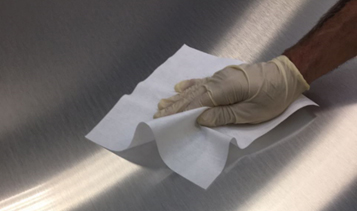
Scratch resistance
Due to its construction, the Aluminum composite panel is a substrate that is relatively easy to damage. Sharp aluminum edges may scratch printed samples if handled without care. For this reason, when printing aluminum panels or metal sheets, follow the next recommendations:
• When handling samples, we recommend wearing protective gloves. The use of gloves prevents from leaving fingermarks or cutting yourself with sharp board edges, and also from accidentally scratching the sample with rings.
• Handle samples with care, avoid hitting samples against corners or sharp edges. Printed samples are not scratch-resistant to keys, knives, cutters or other objects with sharp and hard edges.
• Scratches made on the board prior to printing will still be visible after.
• Use of generic aluminum composite panel media preset is highly recommended. This media preset provides good ink curing settings and resistance performance for most aluminum composite panel brands.
• If there is a need for increased ink curing performance, we recommend modifying the curing height setting to 20 mm. Increasing Overcoat to level 2 may also help to slightly increase the scratching resistance.
• Scratch resistance gets slightly better with time. After 24 h from printing, the sample gets its full scratch resistance.
• When cutting aluminum or metal boards on a table cutter, clean the table from any rest of media previously cut.
• We recommend storing samples in vertical position with a protective layer between samples.
• If horizontal stacking is required, clean the back side of each sample to get rid of any metal particle and protect the samples individually. Do not stack samples on top of each other without a protective sheet between them as edge burrs could easily scratch samples sitting below.
• We recommend placing a foam as a protection between the boards. We recommend not to use the original liner that comes with the aluminum board. We especially discourage to place the liner on top of a printed sample right after printing it and when the board is still hot as there is risk of ink delamination.
• Protect samples when transporting them. Avoid contact and relative movement between boards to prevent scratching.
Film lamination
Film lamination is an effective way of protecting samples printed on metal sheets. It is always a good idea to laminate samples that will be exposed in outdoor conditions for a long time. To laminate samples with film, follow the next recommendations. Important note: the following instructions have only been tested on cold laminates.
• Respect the minimum application temperatures recommended by the film manufacturer. Using lower temperatures might cause adhesion failures.
• Before laminating, make sure that the board is completely clean from any dust particle. All dust specks will be visible after laminating with film.
• After printing, allow the metal sample to cool down completely before laminating. We recommend waiting at least 4 hours after printing. If this time is not respected, there is a risk of ink delamination. Two-side printing When printing on two sides, and to avoid marking the aluminum boards, follow the next recommendations:
• Print first side (side A) using generic settings.
• Print second side (side B) reducing the curing temperature to 80°C










